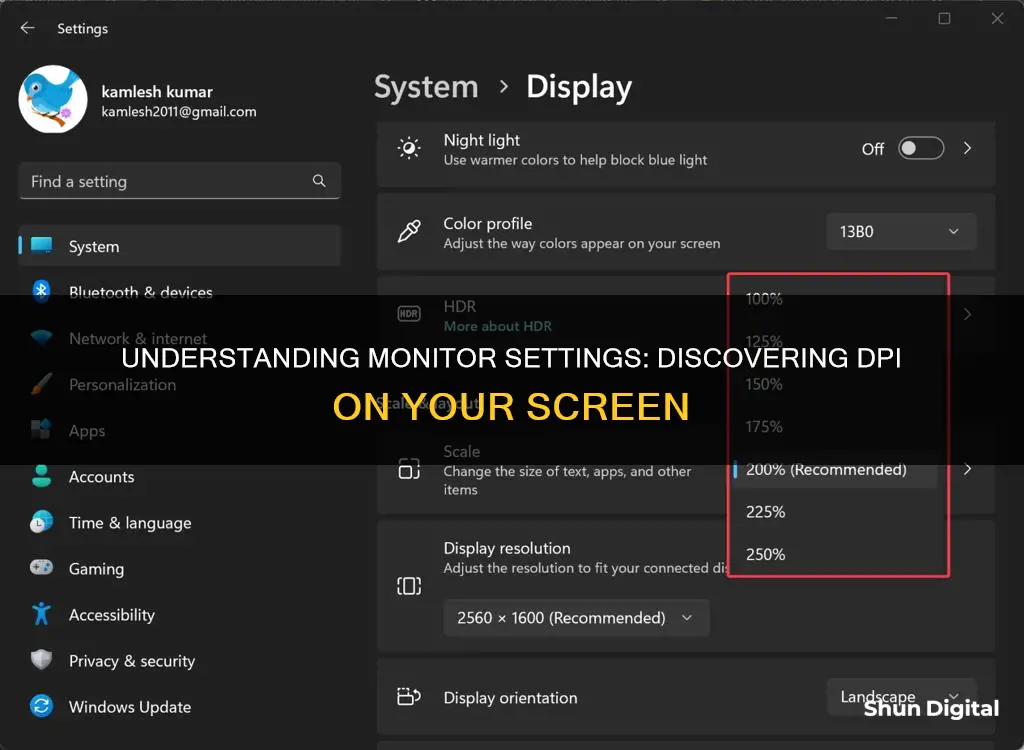
Finding the right display settings for your monitor can be tricky, but it's important to get it right to ensure you can see everything on your screen clearly. The DPI (dots per inch) setting on your computer affects how much content is displayed on your screen, and can make a big difference in how easy it is to read text and view images. In this guide, we'll show you how to find your monitor's DPI setting and how to adjust it if needed. We'll also discuss the recommended DPI settings for different types of monitors, such as those with high resolutions or those using Windows.
| Characteristics | Values |
|---|---|
| How to find DPI on Windows Vista | Right-click on any blank part of the Windows desktop, select Adjust Font Size (DPI), and set the default scale to 96 dpi |
| How to find DPI on Windows XP | Go to Start > Control Panel, double-click Display icon (can also right-click on the desktop and select Properties), and find the DPI setting under the General tab |
| How to find DPI on Windows 7 | Go to Start > Control Panel > Display and choose a size for DPI, or right-click on a blank area of the Windows desktop and select Personalize > Display or Screen Resolution |
| How to find DPI on Windows 8/8.1 | Open the charms by pointing to the upper-right or lower-right corner with the mouse to see the charms (Windows Logo keyboard button + C), select Control Panel > Display, and choose a size for DPI |
| How to find DPI on Windows 10 | Open Settings > System icon > Display and select DPI percentage under Change the size of text, apps, and other items |
| How to check if DPI is detected correctly | Measure a 1"x1" square displayed on your monitor with a ruler; if it is different from 1", then the DPI value should be adjusted |
What You'll Learn

Windows DPI settings
To change the DPI settings in Windows, you can follow these general steps:
- Open the Control Panel.
- Navigate to the "Display" settings. This may involve selecting "Appearance and Personalization" first, depending on your Windows version.
- Look for the DPI setting, usually found under "Change the size of text, apps, and other items" or "Set custom text size (DPI)."
- Adjust the DPI percentage or select a different scaling level.
- Sign out and then sign back in to apply the changes.
The specific steps to change DPI settings may vary slightly depending on your Windows version. For example, on Windows 10, you can also change the DPI scaling level through the Settings app or the Registry Editor.
It's important to note that changing the DPI settings can affect your viewing experience. If the DPI is set too large, some information may appear missing or cut off. Additionally, using a DPI over the default 100% may result in icons being displayed on folders in the Quick Access section of File Explorer.
Best Monitor Size for iRacing: Ultimate Viewing Experience
You may want to see also

How to find DPI on a laptop
There are a few ways to find the DPI (dots per inch) on a laptop, and the method will depend on the operating system your laptop is running.
Windows 10
Firstly, you can check the DPI in the Settings App:
- Open Settings.
- Click on System.
- Click on Display in the left sidebar.
- Under "Change the size of text, apps, and other items", move the slider left or right to the DPI percentage you want to set.
Alternatively, you can change the DPI in the Control Panel:
- Open the Control Panel.
- Select Display.
- Under "Change size of items", click on the "set a custom scaling level" link.
- Drag the ruler left or right to the scaling percentage you want, or select the scaling percentage you want from the drop-down menu.
- Click "Apply", then "Sign out now".
Windows 7
- Go to Start | Control Panel | Display.
- Choose a size you want for DPI size (recommended: Smaller - 100%).
Alternatively:
- Right-click on a blank area of the Windows desktop.
- Select Personalize | Display.
- Choose a size you want for DPI size (recommended: Smaller - 100%).
Another method for Windows 7:
- Right-click on a blank area of the Windows desktop.
- Select Screen Resolution | Make text and other items larger or smaller link.
- Choose a size you want for DPI size (recommended: Smaller - 100%).
Windows Vista
- Right-click on any blank part of the Windows desktop.
- Select Adjust Font Size (DPI).
- Set the default scale to 96 dpi.
Windows XP
- Go to Start | Control Panel.
- Double-click the Display icon (you can also right-click on the desktop and select Properties).
- Under the General tab, find the DPI setting and change it using the drop-down.
Manual Calculation
If you know the screen resolution and the diagonal measurement of your laptop screen, you can calculate the DPI manually. First, calculate the number of pixels displayed diagonally using the Pythagorean theorem, then divide this by the diagonal screen size in inches.
For example, if your laptop has a resolution of 1366 x 768 pixels and a 15.6" screen, the DPI would be approximately 100.
Is My WhatsApp Being Monitored? Signs to Look For
You may want to see also

DPI Scaling Level for Displays
To change your DPI Scaling Level for Displays on a Windows 10 device, follow these steps:
- Go to Settings.
- Select System.
- Click on Display.
- Under the "Change the size of text, apps, and other items" section, select the DPI percentage you want.
- Sign out and then sign back in for the changes to take effect.
If you are using an older version of Windows, such as Windows 7, the process is slightly different:
- Go to the Control Panel.
- Select Appearance and Personalization, then Display.
- In the left column, click on "Set custom text size (DPI)".
- A window will pop up that allows you to adjust the scaling level.
It is important to note that the DPI setting can affect what you can see on your screen. For example, if the DPI is set too large, some information may appear missing or cut off. Therefore, it is recommended to keep the DPI setting at 100% or smaller, especially for resolutions above 1080p.
Dead Pixels: RMA Criteria for ASUS Monitors
You may want to see also

Adjusting DPI font settings
Windows Vista:
Right-click on any blank part of the Windows desktop and select "Adjust Font Size (DPI)". Set the default scale to 96 dpi.
Windows XP:
Go to Start > Control Panel. Double-click on the Display icon (or right-click on the desktop and select Properties). Under the General tab, find the DPI setting and change it using the drop-down menu.
Windows 7:
Go to Start > Control Panel > Display. Choose the size you want for the DPI (it is recommended to select Smaller - 100%). Alternatively, you can right-click on a blank area of the Windows desktop, select Personalize > Display, and choose your preferred DPI size.
Windows 8/8.1:
Open the charms by pointing to the upper-right or lower-right corner of the screen with the mouse. Select Control Panel > Display and choose your preferred DPI size. If you are using Desktop Mode, go to Start > Control Panel > Display and make your selection.
Windows 10:
Open Settings > System > Display. Select the DPI percentage under "Change the size of text, apps, and other items". You may also need to sign out for the changes to take effect fully.
Ubuntu:
You can use tools like "gnome-tweak-tool" or "dconf-editor" to adjust font DPI settings in Ubuntu. These tools allow you to customise font sizes and set numerical values for the "Text Scaling Factor".
Monitoring Water Usage: A Guide for Property Owners
You may want to see also

DPI for Windows 10
To change the DPI settings in Windows 10, follow these steps:
- Change DPI in Settings App: Open Settings by clicking the Start button, then click on the System icon, and select Display. Here, you will find the DPI percentage under 'Change the size of text, apps, and other items'. Move the slider left or right to adjust the DPI to your desired percentage. Sign out for the changes to take full effect.
- Change DPI in Control Panel: Open the Control Panel and select Display. Under 'Change size of items', click on 'Set a custom scaling level'. You can then drag the ruler left or right to adjust the scaling percentage or select your desired DPI from the drop-down menu. Click 'Apply', then 'Sign out now' to finalise the changes.
Note: These settings have been removed from the Control Panel as of Windows 10 version 1703.
You can also change the DPI scaling level for displays in Windows 10 by opening the Registry Editor and making changes to the Win8DpiScaling value.
Additionally, you can check your monitor's DPI by measuring a 1-inch by 1-inch square displayed on your screen. If the displayed square measures differently to 1 inch, adjust your DPI accordingly.
Powering Your LCD Monitor with a Power Bank
You may want to see also
Frequently asked questions
Go to Settings > System > Display. Under "Change the size of text, apps, and other items", you will find the DPI percentage.
Go to the desktop, then right-click on the screen and select "Screen Resolution". From there, select "Make text and other items larger or smaller".
Go to Start > Control Panel > Appearance and Personalization > Display. In the left column, click "Set custom text size (DPI)". A window will pop up showing what percentage of the default monitor DPI your display is currently set to.
You will need to know the pixel count of your screen, as well as the diagonal measurement in inches. You can then calculate the DPI using the Pythagorean theorem.







